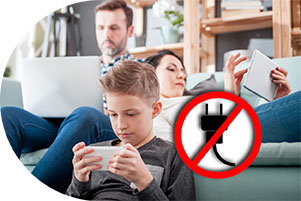Unplug Your Family

It’s March 2020. The COVID-19 virus rears its ugly head and most of us are sent home to isolate. Parents suddenly had to find ways to work with children at home. Binge watching TV (who regrets watching Tiger King?), Zoom gatherings and video gaming became the norm. Netflix subscriptions, Zoom accounts and Disney+ subscriptions soared as people looked for ways to stay entertained through the pandemic. It’s what many of us had to do to work, play and connect. Little did we know how long the situation would last.
Fast forward to today and we now know that the COVID-19 pandemic led to a rise in screen addiction for people of all ages. And there are both mental and physical impacts. For example, in children, research shows excessive screen time can lead to changes in brain structure and neural development. In teens, a study showed those reporting screening times of greater than three hours per day were two-to-three times more likely to have metabolic syndrome—increased blood pressure, high blood sugar, excess body fat around the waist, and abnormal cholesterol or triglyceride levels that occur together, increasing your risk of heart disease, stroke and diabetes.
In adults, those with greater screen time had a nearly 50% increased risk of death from general decreased health, a 125% increased risk of events associated with cardiovascular disease, such as chest pain (angina) or heart attack, and eye strain—tired eyes from intense use. In addition to these health factors, folks who interact excessively with screens may lose the ability to interact in person, collaborate, work in teams and problem solve.
The good news is these trends can be reversed by becoming more self-aware and intentional about changing our behaviors.
The following tips offered by Mayo Clinic might be helpful to you and your family as you try to unplug more often:
Start with yourself. Being aware of your habits can make you a better role model. Set screen time limits or start by deleting one app. Share the improvements you experience with your family and others.
Create a family media plan. The American Academy of Pediatrics’ healthychildren.org has created an English and Spanish template to help you customize a plan for your family overall, as well as each child. Suggested digital media guidelines for children include:
- Before age 2—No digital media, except for video chatting.
- Ages 2–5—Limit to one hour per day of high-quality programming and watch it with them.
- Ages 5 and up—Two hours or less per day.
Stick to the plan. Be prepared to defend your plan and why it may be different in your household than your kids’ peers. Remind your family that the plan was agreed on by everyone, and it applies to everyone—even the grown-ups.
Fill the device gap. Be intentional and find new things to do with your family post-pandemic. Learn to cook new types of cuisine, find new outdoor activities or volunteer together.
Reap the benefits. Recognize and celebrate the things you experience and appreciate with the time you’re unplugged. Journal your gratitude, participate in an artistic activity or craft, or experience and appreciate nature.
Make tech work for you. Use programs and apps that you can set to turn off computers, tablets, and smartphones after a given amount of time.

